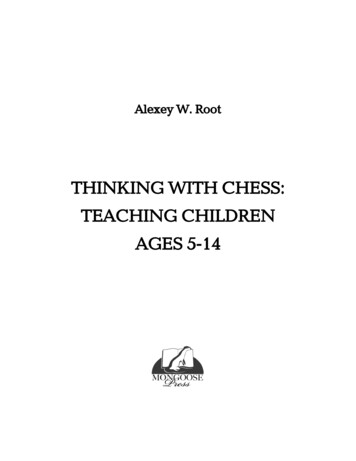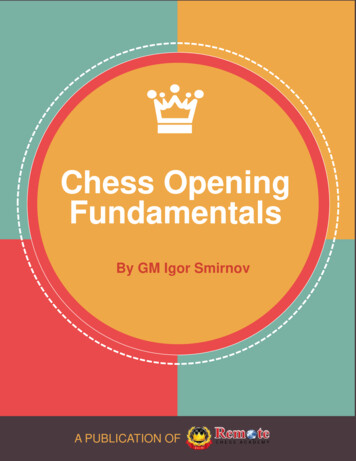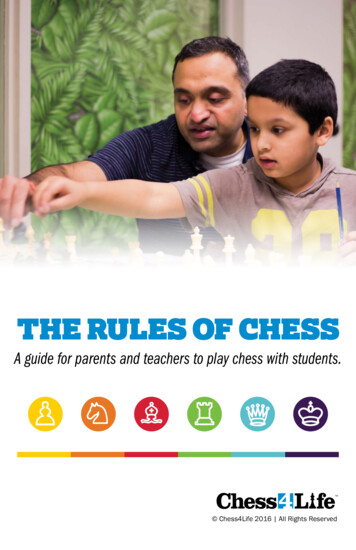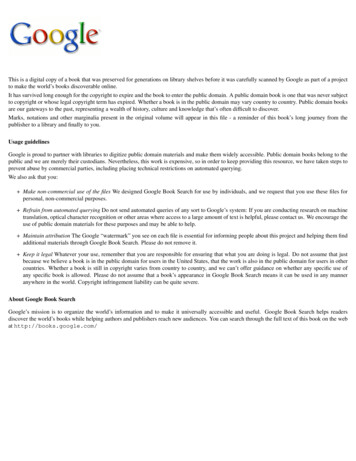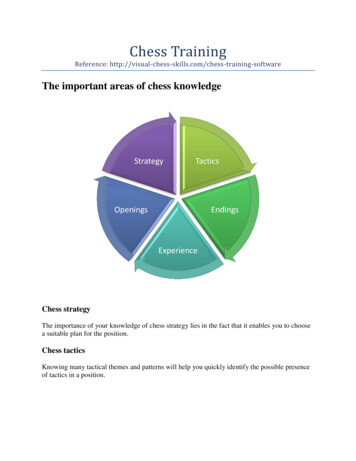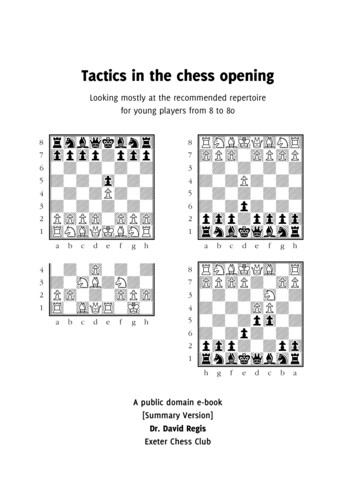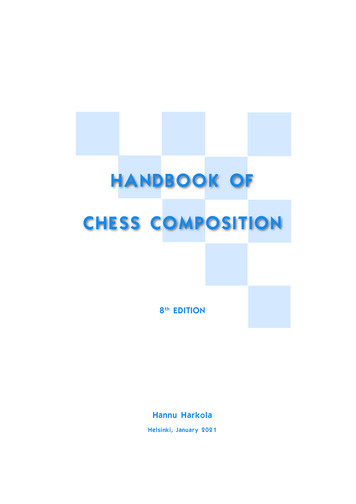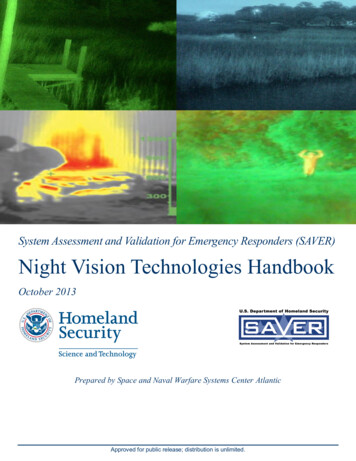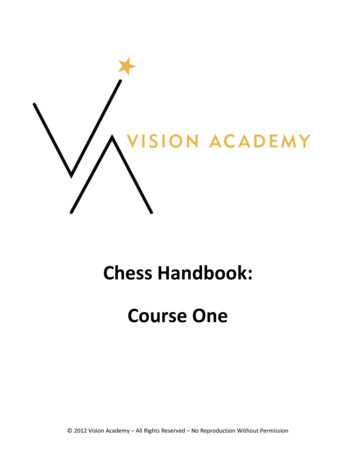
Transcription
Chess Handbook:Course One 2012 Vision Academy – All Rights Reserved – No Reproduction Without Permission
Chess Course One HandbookWELCOME!Welcome to The Vision Academy! We are pleased to help you learn Chess, one of the world’s most wonderful games.This Chess Handbook: Course One, along with your Chess mentor, will help guide you from Basics of game play all theway to Special Moves. Let’s get going!PART ONE: THE BASICS5The Chessboard5The Pieces5Opening Position6Terminology6Draw!7PART ONE: QUICK QUIZ 1, THE BASICSPART TWO: THE MOVEMENTSPawn81010How The Pawn Moves11How the Pawn Captures11How the Pawn Captures (continued)12What it is Worth12Game: Pawn Race12Draw!12Rook12How the Rook Moves13How the Rook Captures14What it is Worth14Game: Rook Hunt15Draw!15PART TWO: QUICK QUIZ 2, PAWNS & ROOKSPage 216
Chess Course One HandbookBishop16How the Bishop Moves17How the Rook Captures18What it is Worth18Game: Bishop Hunt18Draw!18Queen18How the Queen Moves19How the Queen Captures20What it is Worth20Game: Queen Hunt20Draw!20King20How the King Moves21How the King Captures22What it is Worth22Draw!22Knight22How the Knight Moves23How the Knight Captures24What it is Worth24Game: Knight Hunt24Draw!24PART TWO: QUICK QUIZ 3, BISHOPS, QUEENS, KINGS & KNIGHTS25PART THREE: HOW TO WIN26Be Gracious26Be A Good Sportsman26Page 3
Chess Course One HandbookTerminology26Check27Three Ways to Get Out of Check29Moving the King29Interposition29Capturing the Attacker30Checkmate31Stalemate32PART THREE: QUICK QUIZ 3, CHECK, CHECKMATE & STALEMATE33PART FOUR: SPECIAL MOVES34Pawn Promotion34en Passant34Castling35Castling (continued)36PART FOUR: QUICK QUIZ 4Page 437
Chess Course One HandbookPART ONE: THE BASICSThe ChessboardChess is played by two people. Each person gets to make a move when it is their turn. Theyplay on a Chessboard, which has 64 squares, eight rows of eight squares. The squares are blackand white. The Chessboard should be set-up so that each player has a white square in theirright corner.The PiecesThe two people are called “opponents” and they choose one set of pieces (white or black) toplay with. Each opponent has eight Pawns, two Rooks, two Knights, two Bishops, one Queen,and one King.PAWNPage 5KNIGHTROOKBISHOPQUEENKING
Chess Course One HandbookOpening PositionBefore the game can begin the opponents set up the game in Opening Position . Note that theQueen always starts on the square of its own color (white Queen on white square, blackQueen on black square). Also notice that the King is always next to his Queen, and that theopposing Kings and Queens are facing each other directly. White always makes the first move,and starts the game.Page 6
Chess Course One HandbookTerminologyMOVE:A move is the transfer of a Chess piece from one square to another square.CAPTURE: A capture happens when remove your opponents Chess piece from the board.This is allowed only when you replace his or her piece with your piece. The person, who“captures” the piece, uses their hand to remove the piece from the board and places the pieceon the side of the Chessboard.Draw!Use the blank space below to draw a Chessboard .Page 7
Chess Course One HandbookPART ONE: QUICK QUIZ 1, THE BASICSCircle the right answer.a.white1.A Chess game is played bypeople.b.blacka.oneb.twoc.threeWrite in the name of the piece.2.A Chessboard has squares.a.44b.32c.643.The Chessboard should be set up sothat each player has a square intheir right corner.a.blackb.white4.Which color opponent ALWAYS goesfirst?Page 8
Chess Course One HandbookPART ONE: QUICK QUIZ 1, THE BASICS (continued)Write in the answer.What is a Move ?What is a Capture ?Circle the Chessboard with the proper Opening Position :Page 9
Chess Course One HandbookPART TWO: THE MOVEMENTSPawnEach person receives a set of eight Pawns to start the game with. These pawns are placed one each players’ second rank.Page 10
Chess Course One HandbookHow The Pawn MovesOn the FIRST MOVE, the Pawn can move either one or two squares FORWARD. It is important to note that the Pawn canNEVER MOVE BACKWARDS. After the first move, it can only move one square at a time.How the Pawn CapturesThe PAWN is unlike all the rest of the pieces in that it CAPTURES DIFFERENTLY than it regularly moves. CAPTURING isalso known as TAKING.Page 11
Chess Course One HandbookHow the Pawn Captures (continued)What it is WorthEach Pawn is worth ONE POINT. This may seem like a small amount, however consider that there are 8 of them, totaling8 points, we are to understand that when used strategically they are very important.Game: Pawn RaceSet up the board with each players’ Pawns in initial positions along the 2nd Ranks. No other pieces are in play. Eachplayer is to move their Pawns across the board, capturing as they go. The player with the most Pawns on theiropponents 1st rank wins.Draw!Use the blank space below to draw a Pawn .Page 12
Chess Course One HandbookRookEach player receives two Rooks to start the game with. The Rooks are placed in the players corners.How the Rook MovesThe Rook only moves horizontally (the “Ranks”) and vertically (the “Files”). Rooks can move as far as it wants in onedirection horizontally or vertically until it stops on a square, or captures a piece, or encounters an edge. Rooks cannotmove past it’s own pieces.Page 13
Chess Course One HandbookHow the Rook CapturesThe Rook can move into an enemy’s square, so long as it is travelling horizontally or vertically. Once it moves into thatsquare, it captures the piece that occupied it.What it is WorthA Rook is worth FIVE POINTS. This is a strong piece.Page 14
Chess Course One HandbookGame: Rook HuntSet up the game with the Rooks in their corners. Now place the Pawns randomly throughout the Chessboard. Pawns arenot moved once set up, Rooks are only used to capture all of the Pawns. The first player to capture all of theiropponent’s Pawns wins.Draw!Use the blank space below to draw a Rook .Page 15
Chess Course One HandbookPART TWO: QUICK QUIZ 2, PAWNS & ROOKS1. How many points is a Pawn worth?2. How many points is a Rook worth?3. True or False: The Rooks start on the 2nd Rank.4. True or False: The Pawns can move backwards?5. The Pawn captures in which direction?6. True or False: The Rook cannot move diagonally?7. After the first move, the Pawn can only move squares at a time.8. At the start of the game, how many Pawns does each player have?9. The Pawn starts the game lined up on the Rank.10. True or False: Rooks always start the game in the corners.11. True or False: The Pawns captures the same way it normally moves.Page 16
Chess Course One HandbookBishopEach player receives two Bishops to start the game with. The Bishops are placed on the third square in from each corneron the player’s first rank.How the Bishop MovesThe Bishop moves diagonally along square of the same color. Each player has one Bishop that moves along the whitesquares and one Bishop that moves along the black squares. Bishops can move as far as it wants in one directiondiagonally until it stops on a square, or captures a piece, or encounters an edge. Bishops cannot move past it’s ownpieces.Page 17
Chess Course One HandbookHow the Rook CapturesThe Bishop can move into an enemy’s square, so long as it is travelling diagonally along the same color squares. Once itmoves into that square, it captures the piece that occupied it.Bishop to capture Pawn.Bishop captures Pawn.What it is WorthA Rook is worth THREE POINTS. This is an important piece.Game: Bishop HuntSet up the game with the Bishops on their squares. Now place the Pawns randomly throughout the Chessboard. Pawnsare not moved once set up, Bishops are only used to capture all of the Pawns. The first player to capture all of theiropponent’s Pawns wins.Draw!Use the blank space below to draw a Bishop .Page 18
Chess Course One HandbookQueenEach player receives one Queen to start the game with. The Queen is placed on the first rank, in the middle of the board,and always on the same color (i.e. white Queen on white square, black Queen on black square). Also, Queens start thegame directly across from each other.How the Queen MovesThe Queen is the MOST POWERFUL piece on the Chessboard, because it moves like the Rook AND the Bishop. Thatmeans that the Queen can move in any direction vertically, horizontally and diagonally. Queens can move as far as itwants in one direction vertically, horizontally, and diagonally until it stops on a square, or captures a piece, orencounters an edge. Queens cannot move past it’s own pieces.Page 19
Chess Course One HandbookHow the Queen CapturesThe Queen can move into an enemy’s square, so long as it is travelling one direction vertically, horizontally or diagonally.Once it moves into that square, it captures the piece that occupied it. She cannot move or leap over any piece.Notice the Queen can Capture any one of her eight options. Queen chooses to capture Pawn at H4.What it is WorthThe Queen is the most powerful piece on the board and is worth 9 POINTS.Game: Queen HuntSet up the game with the Queens on their squares. Now place the Pawns randomly throughout the Chessboard. Pawnsare not moved once set up, Queens are only used to capture all of the Pawns. The first player to capture all of theiropponent’s Pawns wins.Draw!Use the blank space below to draw a Queen .Page 20
Chess Course One HandbookKingThe King is the MOST IMPORTANT piece in Chess. Notice that the Queen is the MOST POWERFUL, and the King is theMOST IMPORTANT. The reason why it is the most important, is because the point of the game is to capture youropponent’s King. We will discuss how to do this later. Each player receives one King to start the game with. The King isplaced in the middle of the board, on the first rank, next to the Queen, and on it’s opposite color. Also, Kings begin thegame directly across from each other.TASK! Use your pencil to draw a circle around the Kings.How the King MovesThe King can move in any direction, just like the Queen, however it can only move one square at a time. Remember, theKing is “old” and can only move one square at a time.Page 21
Chess Course One HandbookHow the King CapturesThe King can move into an enemy’s square, so long as it is travelling the distance of one square vertically, horizontally ordiagonally. Once it moves into that square, it captures the piece that occupied it. He cannot move or leap over any piece.King is surrounded by many pieces.King captures Knight.What it is WorthThe King is not assigned a point amount, because when you lose the King, you lose the game. Conversely, the King canbe thought of as being worth INFINITE POINTS. Infinity SymbolDraw!Use the blank space below to draw a King .Page 22
Chess Course One HandbookKnightEach player receives two Knights to begin the game with. The Knights are placed on the first rank, one square in from thecorners.Knights look like Horses!How the Knight MovesThe Knight looks like a Horse or Horse’s head because the Knight is the ONLY pieces that can JUMP over other pieces.Yes, it can jump over it’s own pieces or it’s opponent’s pieces. The Knight moves in an “L” shape. This shape iscomposed of two squares over, and two squares up, or two squares up, and two squares over. The “X’s” on the diagrambelow show you where the Knight can move.Page 23
Chess Course One HandbookHow the Knight CapturesThe Knight can capture it’s opponent’s pieces only at the end-square of his move. That means at the end of the Knight’s“L” path, it captures the piece on the square it lands on. But if the piece at the end of the “L” path is the same color asthe Knight, it cannot move there.Knight to capture Pawn.Knight captures Pawn. “X” is where Knight came from.What it is WorthThe Knight is worth 3 POINTS.Game: Knight HuntSet up the game with the Knights on their squares. Now place the Pawns randomly throughout the Chessboard. Pawnsare not moved once set up, Knights are only used to capture all of the Pawns. The first player to capture all of theiropponent’s Pawns wins.Draw!Use the blank space below to draw a Knight .Page 24
Chess Course One HandbookPART TWO: QUICK QUIZ 3, BISHOPS, QUEENS, KINGS & KNIGHTS1. How many points is a King worth?2. How many points is a Queen worth?3. True or False: The Knight start on the 1st Rank.4. True or False: The Queens can move only one space at a time?5. Can the Knight captures it’s own pieces?6. True or False: The Bishop cannot move diagonally?7. True or False: The Queen is the MOST IMPORTANT piece in the game.8. At the start of the game, how many Bishops does each player have?9. True or False: The Queen starts the game on her own color.10. True or False: Bishops always travel along one color.11. True or False: The Knight cannot jump over other pieces.Page 25
Chess Course One HandbookPART THREE: HOW TO WINBe GraciousChess is a wonderful game. It provides each opponent with the opportunity to play, learn and strategize. Like all games,the outcome results in one winner and one loser. Regardless if you are the winner of the game or the loser of the game,you should be proud of playing your best and be GRACIOUS to your opponent. After a game has concluded, in a promptand positive manner, congratulate your opponent, and thank them for the game (offer a handshake and say “goodgame.”)Be A Good SportsmanGood sportsmanship means acknowledging victories without humiliating opponents, being quietly proud of success, andletting victories speak for themselves. Even if you win by a landslide, good sportsmanship means still finding ways tocompliment your opponents.TerminologyWIN:Winning the game of chess means you have placed your opponent’s King in “Checkmate.”LOSE:Losing the game of chess means your opponent has placed your King in “Checkmate.”DRAW:A draw is a tie. This means each opponent has fought the ga
Chess Course One Handbook PART ONE: THE BASICS The Chessboard Chess is played by two people. Each person gets to make a move when it is their turn. They play on a Chessboard, which has 64 squares, eight rows of eight squares. The squares are black and white. The Chessboard should be set-up so that each player has a white square in their right .
